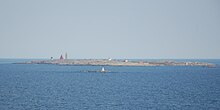Vinga (Gothenburg)
- Machine translation, like DeepL or Google Translate, is a useful starting point for translations, but translators must revise errors as necessary and confirm that the translation is accurate, rather than simply copy-pasting machine-translated text into the English Wikipedia.
- Do not translate text that appears unreliable or low-quality. If possible, verify the text with references provided in the foreign-language article.
- You must provide copyright attribution in the edit summary accompanying your translation by providing an interlanguage link to the source of your translation. A model attribution edit summary is
Content in this edit is translated from the existing Swedish Wikipedia article at [[:sv:Vinga]]; see its history for attribution. - You may also add the template
{{Translated|sv|Vinga}}to the talk page. - For more guidance, see Wikipedia:Translation.

Vinga is a small island 10 nautical miles (19 km; 12 mi) outside Gothenburg's harbour entrance in Sweden. The 19th century Vinga Lighthouse is noted, not only as a beacon in the waterway of the Swedish west coast, but also as the place where the Swedish poet laureate Evert Taube grew up. Today Vinga is a tourist attraction, with boats to and from Gothenburg harbour.[1]
Geology
The bedrock of Vinga is mostly made up of porphyrite (porfyrit), a volcanic rock with less Silicon dioxide, SiO2, than porphyry. The rock has a fine-grained structure, dark with lighter grains of feldspar and other minerals. The mineralogical composition of the Vinga porphyry classifies it as a monzogranite or quartz diorite. The northern part of the island contains orthopyroxene. The Vinga porphyry was created about 950 million years ago, when it penetrated the surrounding older gneiss rock.[2]
References
- ^ "Vinga – Porten till Göteborg och Västkusten" [Vinga – Gate to Gothenburg and the West Coast]. www.vinga.net. Vinga.net. Retrieved 24 August 2015.
- ^ Årebäck, H; Andersson, UB; Petersson, J (2008). "Petrological evidence for crustal melting, unmixing, and undercooling in an alkali-calcic, high-level intrusion: the late Sveconorwegian Vinga intrusion, SW Sweden". Contributions to Mineralogy and Petrology (93): 1–46.
57°38′N 11°36′E / 57.633°N 11.600°E / 57.633; 11.600
- v
- t
- e
 | This Swedish geography article is a stub. You can help Wikipedia by expanding it. |
- v
- t
- e










